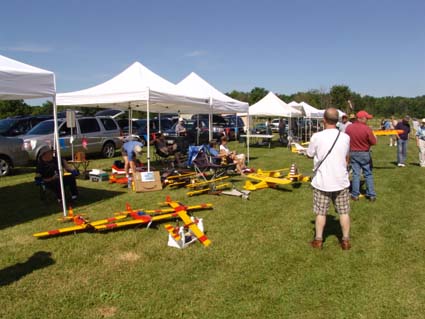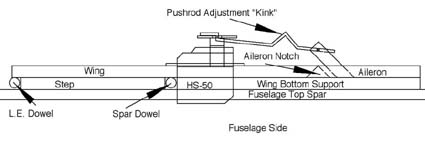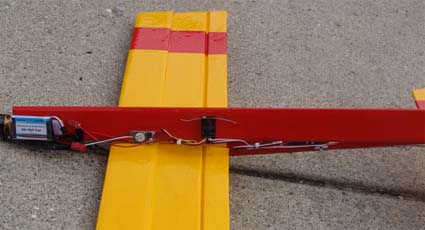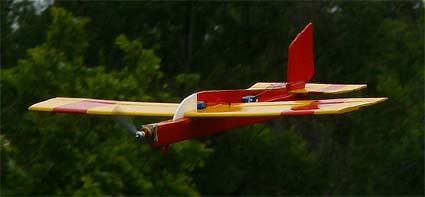 |
Flying High With Electric Power!
The Ampeer ON-LINE!
Fly the Future - Fly Electric! |
Site Table of Contents
| President: | Vice-President: | Secretary/Treasurer: |
| Ken Myers | Richard Utkan | Rick Sawicki |
| 1911 Bradshaw Ct. | 240 Cabinet | 5089 Ledgewood Ct. W. |
| Commerce Twp., MI 48390 | Milford, MI 48381 | Commerce Twp., MI 48382 |
| (248) 669-8124 | (248) 685-1705 | 248.685.7056 |
 | ||
| Board of Directors: | Board of Directors: | Ampeer Editor |
| David Stacer | Jack Lemon | Ken Myers |
| 16575 Brookland Blvd. | 8908 Sandy Ridge Dr. | 1911 Bradshaw Ct. |
| Northville, MI 48167 | White Lake, MI 48386 | Walled Lake, MI 48390 |
| 248.924.2324 | 248.698.4683 | 248.669.8124 |
| Mailed Ampeer subscriptions are $15 a year US & Canada and $20 a year world wide. FREE on-line! | ||
| The Next Flying Meeting:
Date: August 1 Time: 10:00 a.m. Place: Midwest RC Society 7 Mile Rd. Flying Field, Salem Twp., MI | ||
| What's In This Issue? | |||
| RC Advisor's ModiFly | The Myers' ModiFly | The June EFO Flying Meeting | Own a Bob Aberle Review Plane |
|
When subscribing to or renewing the paper version of the Ampeer, please make the check payable to Ken Myers. We do not have a DBA for the Ampeer or EFO. Thanks, Ken
Design and Build From Scratch Your Own Flying Model Airplane In One Day For Just $5 A Review and More By Ken Myers The creator of "Brainy Calculator" at www.rcadvisor.com, Carlos Reyes, has a new, follow-up book coming out on the heals of his successful RCadvisor's Model Airplane Design Made Easy.
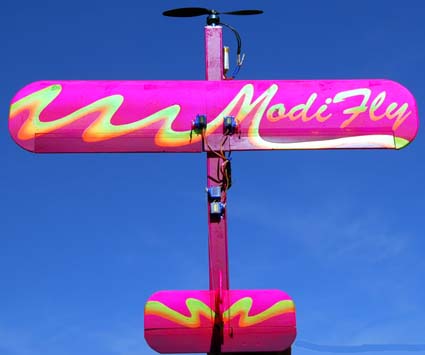
Photo from RC Advisor's ModiFly book What I Learned from This Book 1.) The wing uses a KFm1, bottom-stepped, flat-plate type airfoil. I was only aware of the KFm family of airfoils from Carlos' first book. 2.) All 1/8" dowel is not really 1/8" in diameter. The book lists the actual diameters of various 1/8" dowel found at local sources. 3.) Foamboard is a good source of foam sheets. 4.) I learned the best, cheapest way to remove the "board" from the foam of Foamboard is to soak it in the bathtub for a few hours and then peel and "roll" the paper off finishing up by rubbing the foam with an old tee-shirt to remove the remaining paper. Carlos gives other tips and other ways of doing it in the book. 5.) You can't count on one source having everything you need to complete any project, whether it is material for the airframe, or the onboard radio components, or the power system components. Plan ahead! Using Carlos guidelines, tips and ideas, the Myers ModiFly took shape in my mind and on "paper." Here is some information from the author. KM How does an original model airplane design get created?
Incorporating the latest innovations and research results, the design is deceptively simple in appearance. However, 20 prototypes and 15 hours of flight-testing were required before a design finally met all the goals:
You can easily find the construction materials for the airplane at local discount or craft stores. So what are you waiting for? The book starts by describing the goals and the long prototyping process that led to the final design. Along the way you get to see firsthand the challenges that creating an innovative design presents.
Learn the reasoning behind all the decisions that led to this unique design.
"This is absolutely A MUST READ!" - Bob Aberle "I am so excited about the design that I just have to build one to try it out." - Ken Myers "Carlos kicks out another winner with this one." - Jamie Burke "Even if you have some model airplane design experience, you are likely to learn something from this book. I know I did." - Paul Bradley "Carlos Reyes has done it again!" - Richard Kline "Lots of great info!" - Michael "Crash" Hancock "Carlos' latest book is like a well written mystery novel." - Red Scholefield The book is just $19.95. That is a lot less than the price of a new kit! As a bonus, I'm including a *free* six month subscription to the premium features of the calculator. That is a $12 value! This subscription unlocks the optimizer and all the other advanced calculator features. Current subscribers can extend their subscription for another six months with this offer. As a service to the RCadvisor community, I'm making available flight packs suitable for the model described in the book. These are the same high quality components I used in all my flight-testing: * HXT 5 gram micro servos (4 each)
The price of the flight pack is just $74.95, a real bargain. Bonus: for a limited time, I'm adding an extra propeller for a total of two. While supplies last, I'm throwing in free high quality vinyl stickers with every order. They are three-inch high copies of the RCadvisor logo in full color. The vinyl is only 0.002 inches thick and is self-adhesive. They look great!
Carlos Reyes
The Myers' ModiFly I MUST make it clear that the following was purely optional on my part. Everything you need to know and do is in the book! The following is just my way of having fun.
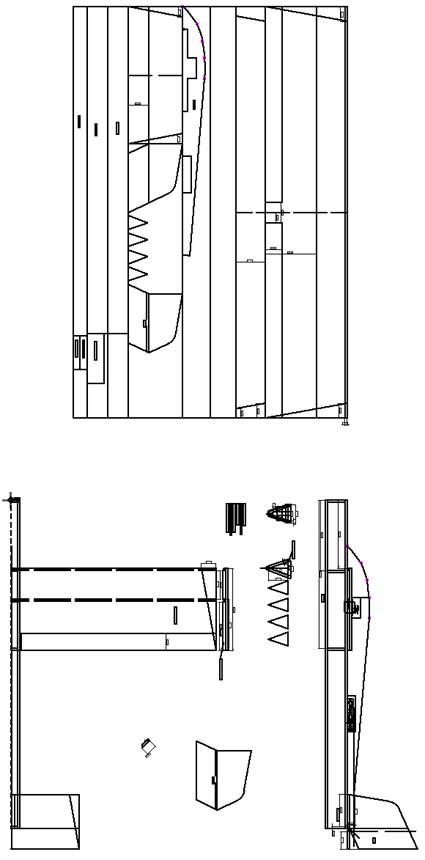 Also, while I was drawing up the parts in CAD, I created a spreadsheet to see about how much the completed airframe might weigh. |
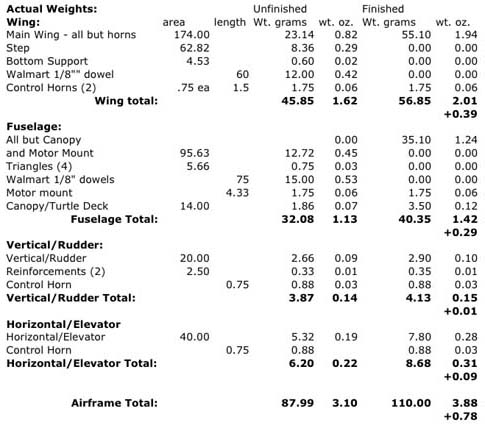
|
Once the airframe was completed and covered, I added the finished weights to the spreadsheet.
No Load Partially charged 2S1P Li-Poly average -
Fully charge 3S1P "A123" 2300mAh average -
Scorpion states that the Kv is 1980 and Innov8tive Designs says 1979. It looks like we are all playing in the same corner of the sandbox. Prop Data Averages Note that all of the prop data was gathered from the same charge on the battery and does not illustrate the maximums with any particular prop, except the APC 7x4E that was the first one to be tested.
GWS 7x3.5 DD: 7.27 volts, 6.42 amps, 11413.2 RPM, pitch speed 37.8 mph, system eff. ~70.6% Cox 6x4 Gray: 7.128 volts, 6.94 amps, 10857.6 RPM, pitch speed 41.1 mph, system eff. ~69.2% APC 6x5.5E: 6.948 volts, 7.56 amps, 10172.2 RPM, pitch speed 53 mph, system eff. ~67.2% APC 7x4E: 7.404 volts, 9.92, amps, 9825.8 RPM, pitch speed 37.2 mph, system eff. ~61.9% Motor: Max. Cont. Current 12 amps * 0.8 = 9.6 amps
The numbers suggest that the GWS and Cox props can be used and should provide a good safety and longevity margin. The numbers for the APC 6x5.5E also suggest that I may want to give it a try for the "full sports car" version if I am willing to risk some of my investment. Obviously, the APC 7x4E should not be used.
 The Ready To Fly weights:
1. Top Flite Econokote was used to cover the airframe and make folded hinges for the ailerons, elevator and rudder. 2. The wing step width was reduced to 2-1/8" to allow for some setback of the leading edge dowel. 3. Water thinned Titebond Original Wood Glue was used for laminating, 30-minute Epoxy for attaching the wing, horizontal stab, vertical stab and motor mount to the fuselage and Titebond to attach the canopy/turtle deck. 4.) I chose a completely different "mission goal" for my version with a totally different power system. 5.) I chose a different brand of servos and ESC. 6.) I used 3 servos instead of 4. 7.) Push rods with "V" bends were used to allow for field adjustments of the trims. I prefer to adjust the flight control surfaces and keep the trims neutral on the transmitter. 8.) The wing tips, horizontal stab/elevator and vertical stab/rudder were angled instead of rounded. 9.) The aileron width was changed to 1-1/4" because they extend to the tips. 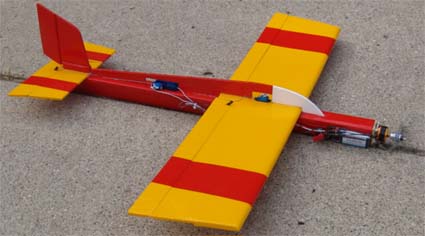
If I were to do the plane over again today, I would use a Scorpion S-2205-36 1750Kv motor. Using the -36 would allow me to use a wider selection of 7- and 8-inch diameter props that are available today. The Cox 6x4 is no longer available. I would move the rudder and elevator servos back one inch.
The Myers' ModiFly was maidened on July 4th. It was a great day for a maiden. The slight breeze was variable, but it was usually right down the runway, and the temperature was in the low 70s. I had my flying buddy, Jim M., hand launch it for me. It headed pretty quickly towards the ground, but a yank on the stick brought it up and flying. Most of the first flight was spent trimming it out. It flew fine, but I wanted to get it trimmed well so that I could adjust the push rods when I landed. I set the timer for 3 minutes and the landing was easy and uneventful.
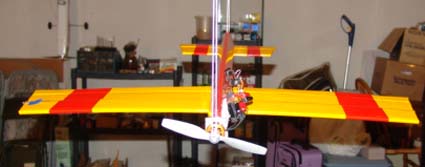 The photo shows the whole nail already inserted into the foam of the left wing tip and the partial nail taped on to check the balance. Both nails were inserted just ahead of the spar dowel, very close to the CG. 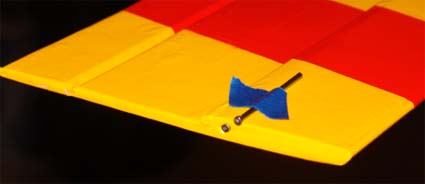
Close up of inserted nail & partial nail I took the laterally balanced plane to the field on July 8 for five more flights. It is flying much better now and does not have a tendency to corkscrew out at the top of loops.
The June EFO Flying Meeting The June EFO flying meeting was scheduled for June 20, but it was a rainy, windy Saturday. The meeting was rescheduled to the June 27 and it could not have been a more perfect day!  Denny Sumner had out his new, all foam "North Star" for its maiden. It flew great! His Ryan's Daughter kept it company at the field. 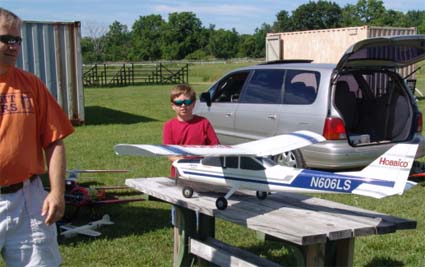 Jim and Tim Young had a lot of fun flying Tim's trainer. 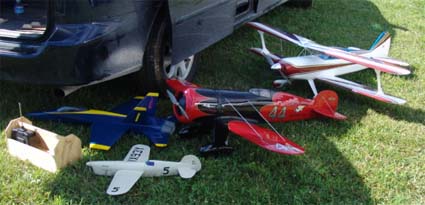 Jim also had several of his fantastic flying planes with him on this perfect flying day.  Dave Stacer brought along quite a few planes as well. His SR Batteries AcroPro is in the front with several "foamie" wings. The ElectroFlying Fusion was about to be unloaded from his Ford Fusion.  Rick Sawicki had his fleet out as well.  It certainly was a day for fleets, as Paul Sockow looks over his. 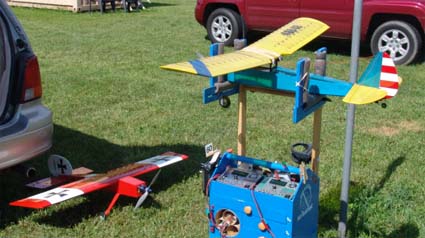 Roger Wilfong flew the heck out of his SR Batteries Cutie and ElectroStick.  Ken Myers had out his Fledgling trainer for use by student pilots. He also brought along the finished ModiFly airframe and his Son of Swallow.
 Jesse had his Ultra Stick 25e up for several flights. 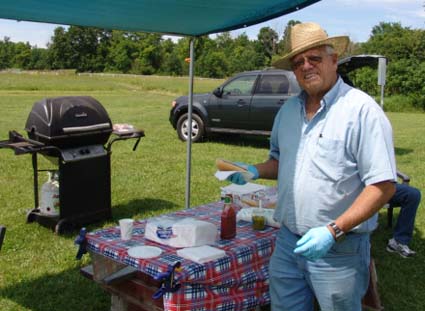 Jim Lapham grilled us hot dogs for lunch and we washed them down with lemonade. What a nice and welcome surprise! Thanks Jim!
Own a Bob Aberle Review Plane
Bob Aberle needs to "clean out" his fleet and has five planes that he's reviewed for various publication for sale. He is willing to ship them, but it would be even better for you to pick them up at the N.E.A.T. Fair in is Downsville, NY on September 18 - 20, 2009. The prices are somewhat negotiable, within reason. Please contact Bob if you are interested. I've created an Acrobat .pdf file with a full description of each plane, where it is reviewed and what is included. Use the URL noted to "pull up" the .pdf file. NOTE, URLs no longer active for purchase of these planes. Multiplex-USA BLIZZARD high-performance electric sailplane
HOBBY LOBBY BONNIE-20 -- trike gear as well as a set of Twin Floats and all mounting hardware
Horizon E-Flite DHC-2 BEAVER with full scale operating flaps and provision for adding twin floats
GRAUPNER TAXI CUP-II
Horizon E-Flite "MINI ULTRA STICK"
Please be sure to check the .pdf files for the exact details of what is included and pricing. I've tried not to make any errors while copying the information here, but the .pdf files have the correct pricing and details. KM |
To Reach Ken Myers, you can land mail to the address at the top of the page. My E-mail
address is:
KMyersEFO@theampeer.org
< href="http://www.theampeer.org" target=_blank>EFO WEBsite
